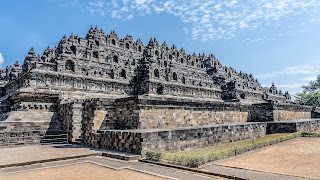Postingan update
- Dapatkan link
- X
- Aplikasi Lainnya
This magnificent temple is more than simply a breathtaking sight with its recognizable stupas, ornate stone reliefs, and breathtaking natural surroundings. Even more fascinating than its majestic exterior are the stories, symbols, and revelations of Borobudur. Discover the most gorgeous temple in Indonesia, Borobudur, by reading on.
The Borobudur Temple provides a peek into life in the area in the eighth century. The Syailendra Dynasty, which translates to "Lord of the Mountain," ruled the region at the period and vigorously promoted Mahayana Buddhism there.
During the height of their power, this Buddhist dynasty constructed the Borobudur Temple, which is thought to have taken 75 years to complete. The temple, which was mostly constructed from stones, was built piece by piece utilizing a sophisticated pattern system to lock each of the 2 million blocks together rather than cement or adhesive.
Sadly, this powerful temple was abandoned when the dynasty moved its capital from the prone to eruption Central Java to East Java. The modification was done somewhere in the 10th century and had an effect on nearby temples, particularly the Hindu Prambanan Temple, which was erected decades after Borobudur.
Others claim that the 14th-century introduction of Islam, when Javanese people began to convert quickly to Islam and the influence of Hindu and Buddhist kingdoms started to decline, was more responsible for the ultimate abandonment of the region.
Nevertheless, the dense volcanic ash and lush flora that were there when the temple was rediscovered in 1814 by Sir Thomas Stamford Raffles, the British administrator of Java, provided evidence of its long desertion. Following its recovery, the temple's existence was made known to the public, and restoration efforts were started.


Komentar